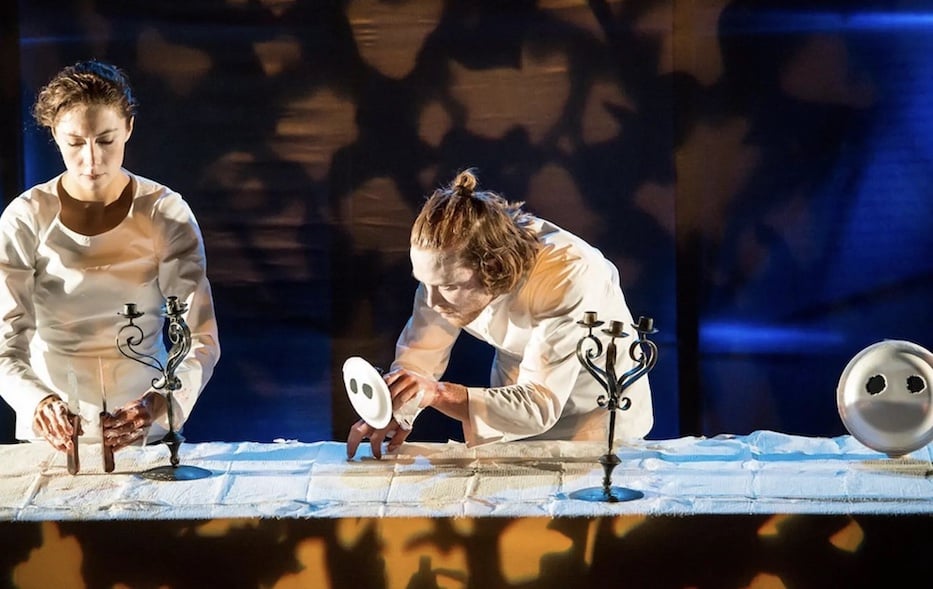
La Fille du Latier Photo.
Have you ever become emotionally attached to a paper plate?
After watching La Fille Du Laitier’s stirring Macbeth Muet, I have. This wordless performance uses mime, music, clowning, and puppetry of everyday objects to tell a virtuosic version of the Shakespearean classic.
It’s not one to miss before it leaves town. The show, part of the International Festival of Arts & Ideas, runs at the Iseman Theatre in downtown New Haven through June 15. Tickets and more information are available here.
For those who may need a brush up on Macbeth, here it is. Three witches find Scottish lords Macbeth and Banquo in the heat of battle, and tell them that Macbeth will be king and Banquo’s children will also be kings. Macbeth confides the prophecy in his wife, Lady Macbeth, who encourages him to make the promise a reality by killing the current king. They do.
But as Macbeth ascends the throne, the couple becomes tortured by what they have done. In a paranoid, murderous spree, Macbeth has Banquo killed, as well as many others he sees as a threat to his power. Meanwhile, Lady Macbeth is consumed by guilt, goes insane, and dies. Macbeth's political rivals challenge him to battle, resulting in his beheading. Banquo’s son eventually becomes king.
In Macbeth Muet, the stage is set with a single table covered in plastic tablecloths, trash bins to either side. It's very much a promise of the mess to come. Three black cootie catchers (yes, straight from your elementary school playground) perch harmlessly atop the table. When performers Jérémie Francoeur and Marie-Hélène Bélanger Dumas take the stage, the paper fortune tellers come to life as the three witches who lure Macbeth to his doomed fate.
Through the specificity of their puppeteers, the witches skitter like spiders to whisper promises of power in Macbeth’s ear, leaving him with a black piece of paper inscribed with the words “Macbeth will be King.”
This kind of clear, playful, and unpretentious choice is a hallmark of the production. The audience is invited into the language of the play even as no language is spoken.
Everyday objects are imbued with meaning through physicality and play. Candlesticks become a forest. A hockey glove is a dreaded enemy, and an egg a precious child. Music and sound are used to great effect, with upwards of 180 short clips grounding the audience immediately in the tone and emotion of a scene.
Some standouts included Bill Withers and Grover Washington, Jr.’s “Just the Two of Us,” which scores a sweet father-son bonding session between the ill-fated Banquo and his son, as well as a potent selection of Simon and Garfunkel's “The Sound of Silence” for Lady Macbeth’s sleepless nights.
During opening night Tuesday, the performers maintained a sense of tension and grounded-ness throughout the 60-minute run, aided in part by these kinds of artistic choices. The Macbeths’ insomnia, for instance, became an accelerated night in bed, their twitching and convulsing magnified in the long shadows they cast on the wall behind them.
What started as a chase after Banquo’s ghost—represented by a tablecloth— ended with Macbeth’s hands around his wife’s neck. The few moments of silence rang loud in contrast to the noise-filled, rapid pace the audience to which had become accustomed.
The humor and accessibility of the piece was (and is) also part of what made the real tragedies, big and small, stick their landing. Many of these moments arrived in the addition of three “prequels” peppered throughout the show.
Each showed a different couple— the Macbeths, the Banquos and the Macduffs— and their journey to parenthood. While Macbeth's barren household is referenced in the original 1606 text, there is only so much room to explore it. Here the couple pantomimes their meeting, engagement, wedding, sex, and conception of a first child represented by a single white egg. Lady Macbeth picks up the egg to cradle it and it breaks.
The gesture is repeated as the couple loses child after child. In two alternate attempts, it becomes aggressive, haphazard as the egg breaks. Finally Lady Macbeth lets out a guttural scream as she cleans up the gooey mess. By showing the audience a representation of that experience, we learn something new and visceral about their motivations for power.
None of this nuance and delight would be possible without the mastery on display by the two performers. Marie-Hélène Bélanger Dumas, who played Lady Macbeth among many (many) others, is an original co-creator of the piece. The first iteration was a five minute version, which has continued to develop in length and scope since 2016.
Dumas’s Lady Macbeth is sharp, haunted and unique. Alongside her, Jérémie Francoeur brings heart and bravado to his Macbeth while seamlessly slipping between his many other characters. Their work as a pair is perfectly tuned and skillfully guided by director and co-creator Jon Lachian Stewart.
Macbeth Muet’s has identified what is most essential in the source material—the relationships that fascinate us. The dark impulses which are cosigned and explored. The depth of grief in the loss of a child. The supernatural lurking in the mists. The absurdity of fate, death, and destruction. These imperatives are explored with athleticism, humor, grit, and yes, paper plates.
Macbeth Muet runs at the Iseman Theatre through June 15. Tickets and more information here.